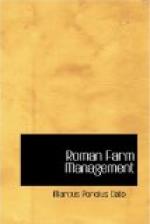A further proof that country life was earlier than that of town is found in the name of the town of Thebes, which was bestowed from the character of its situation rather than from the name of its founder: for in the ancient language, and among the Aeolians who had their origin in Boeotia, a small hill is called tebas without the aspirate; and in the Sabine country, where Pelasgians from Greece settled, they still have the same locution: witness that hill called Tebae which stands in the Sabine country on the via Salaria not far from the mile stone of Reate. At first agriculture was conducted on so small a scale that it had little distinction, since those who followed it, being sprung from shepherds, at once sowed their corn and pastured their flocks on the same land, but as later this art grew in importance the husbandry of live stock was separated, and it befel that some men were called farmers and others shepherds.
The art of feeding live stock should really be divided into two branches, as is not yet fully appreciated, one relating to the stock kept at the steading, the other to the stock pastured in the fields. The latter, which is designated by the name pecuaria, is well known and highly esteemed so that rich men, either lease or buy much pasture land in order to carry it on: the other, which is known as villatice, has, because it seemed to be of less importance, been treated by some as an incident of the husbandry of agriculture, when in fact it should be made a part of the husbandry of live stock: nor has it been described separately and at length by any one, so far as I know.
And so, as I think that there are three branches of farm management which are undertaken for profit, namely: agriculture, live stock and the industries peculiar to the steading, I have planned three books, of which I have already written two, the first concerning the husbandry of agriculture, which I dedicated to my wife Fundania, and the second concerning the husbandry of live stock to Turranius Niger: the third, relating to the profits of those industries which are carried on at the steading, I now send herewith to you; for the fact that we are neighbours and entertain a mutual affection seems to demand that it should be dedicated to you above all others.
Although you have a villa, which is remarkable for the beauty of its workmanship within and without, and for the splendour of its mosaic pavements, still you deem it to be bare unless you have the walls decorated also with books: so in like manner that your villa may be more distinguished by the profits you derive from it than by the character of its construction, and that I may be of assistance to that end, so far as may be, I have sent you this book, which is a summary of some conversations which we have had on the subject of what makes the perfectly equipped villa: and so I begin as follows:
Of the definition of a Roman villa




